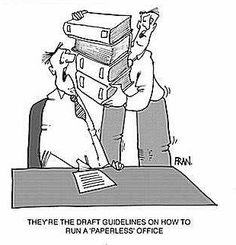In recent months there has been a whole raft of change and transformation that has taken place within the now, not as traditional, law firm. Some of it has been forced by external factors and some of it has been driven from within. This has also led to further knock-on changes that didn't seem on the horizon or at all possible 6-12 months ago. One of these is the unthinkable notion that a law firm could go paperless.
Like all things especially in the world of law and professional services, change needs to come about with process and structure and an overarching goal. Going paperless is no different and in many firms outside of law, has been totally achievable. Law firms are slightly different however and have always been heavily reliant on text-books, case files and quite literally the (physical) letter of the law. I recently came across a great article from Adam Cohn (Head Of Marketing At Kilburn & Strode) where he highlights some pointers to help drive the paperless train. They are pointers that can be applied to driving any project through successfully.
First, build a case- A large portion of the firm will be working remotely for the foreseeable future and therefore the case is slim for the need of physical files to be stored and accessed. In fact, the files or 'paper' will need to be accessed from anywhere.
 Change the culture- This is something that is often mentioned when driving a project within a law firm or the professional services arena. However, the difference now is that most fee earners have embraced or are ready to embrace the unknown. Firms should try and nail both flexible and agile working at the same time and in doing so they will need to arm workers with the right tools to succeed.
Change the culture- This is something that is often mentioned when driving a project within a law firm or the professional services arena. However, the difference now is that most fee earners have embraced or are ready to embrace the unknown. Firms should try and nail both flexible and agile working at the same time and in doing so they will need to arm workers with the right tools to succeed.Cost-saving- Firms are seriously looking at, or have already, reduced office space and size. Employees not going into the office is one reason but reducing the working area by cutting down on things like paper storage is also another compelling reason to throw into the mix.
How to achieve it- Always get a champion and decision-maker on board (normally a senior leader) and then make your case for change. Adam suggests the following to help make it stick:
- Scope the project and build a task force
- Map it out- Capture all paper use because there will be more than you think
- Leverage an electronic document management system- better still, build internal processes around how and why it should be used.
- Physically get rid of paper files- this is the big task as all paper will now need to be scanned and transferred to the cloud.
- Create workflows- Speak with IT to see what is possible and if nothing is, then look outside the firm for a provider.
- Super users- make sure they are comfortable with the end goal and are trained in all things paperless.
- Slow adopters- Be wary and don't veer off course or lose sight of the main objective. Keep working on them in the background.
Make sure your kit can handle it- Make sure that everyone has the right software, laptop capability and user experience so that they can easily help achieve the goal.
Build an internal campaign- Create compelling messaging and positive feedback that can be drip-fed through before during and in the future.
Develop the habits- Keep learning and evolving as well as keeping an eye on progress. Be sure to be working in the most efficient way and be open to new project management and communication tools.
Adam signs off with a nice play on word's "Whatever you do, don't remain stationary, ditch the stationary (and paper)





/Passle/53d0c8edb00e7e0540c9b34b/MediaLibrary/Images/2025-06-24-15-50-59-531-685ac963d81bf11b7522dd8e.png)
/Passle/53d0c8edb00e7e0540c9b34b/MediaLibrary/Images/2025-12-18-10-52-26-493-6943dceac311190ddba15d64.jpg)
/Passle/53d0c8edb00e7e0540c9b34b/MediaLibrary/Images/2025-12-16-15-16-25-843-694177c9190f803408651724.jpg)
/Passle/53d0c8edb00e7e0540c9b34b/MediaLibrary/Images/2025-12-09-11-05-31-284-6938027b1b6076d9d8980f1e.png)
/Passle/53d0c8edb00e7e0540c9b34b/MediaLibrary/Images/2025-12-04-20-27-35-105-6931eeb7f170698845c6b19b.jpg)



